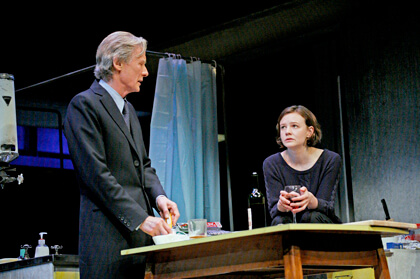Morgan Spector, Geneva Carr, Heather Lind, and Charlie Cox in Nick Payne’s “Incognito,” directed by Doug Hughes at City Center through July 10. | JOAN MARCUS
The new theater season is only a few weeks old, but it’s safe to say Nick Payne’s “Incognito” will be one of the most exciting plays you’ll see this year. That may be even more surprising when one realizes that the play is ostensibly about brain function. Or, more accurately, about how much we cannot know about how our brains work but how much we want to.
The play is loosely based on several true stories, including that of Thomas Harvey who removed Einstein’s brain during the great man’s autopsy and kept it to study for nearly 40 years. It’s also the story of Henry Mason, a man whose brain seems to have no capacity for short-term information retention, and of Evelyn Einstein who believes she is the adopted daughter of Einstein’s son but might actually be his much younger half sister. In all, over the course of 90 minutes, we meet some 20 people whose lives intersect and overlap. It is not so much a plot-driven piece as a human collage, and the cumulative power of it by the end is profoundly moving.
Far more poetic and abstract than Payne’s previous work, “Constellations,” its underlying questions are how do we know what we know and what defines who we are? Payne doesn’t attempt any answers, but rather marvels at the incomprehensible complexity of it all, just as do we in watching.
“Incognito” absorbs, “Hadestown” aims high, “Paramour” dazzles
Directed with absolute precision by Doug Hughes with movement by Peter Pucci on Scott Pask’s magnificently minimal set with Ben Stanton’s gorgeous and understated lighting, the play recalls Archibald MacLeish’s “Ars Poetica,” in which he writes, “A poem should not mean/ But be.” The power of this piece is in the total experience of it as it unfolds, as we’re drawn into disparate lives and marvel at the power of the couple of pounds of meat we all have in our heads.
The four-member cast is stunning. Geneva Carr, Charlie Cox, Heather Lind, and Morgan Spector playing multiple characters bring each one levels of originality and specificity that make them distinct and moving.
Neuroscience may not necessarily be an obvious topic for popular theater, but in Payne’s hands it becomes fascinating and deeply human. But then after all, it is the stuff we are made of.
Amber Gray in Anaïs Mitchell’s “Hadestown,” directed by Rachel Chavkin, at New York Theatre Workshop through July 3. | JOAN MARCUS
“Hadestown” is not, strictly speaking, a musical. It began life as a concept album by Anaïs Mitchell and has been developed with and directed by Rachel Chavkin. It’s an operatic — as in almost completely sung-through — setting of the myth of Orpheus and Eurydice, and the music is sublime. A combination of styles, with a heavy emphasis on folk and country, Mitchell’s harmonies and melodic lines can make the hair on the back of your neck stand up. Though its genres are familiar, the music, with orchestration by Michael Chorney, is fresh and exciting.
As a theater piece, “Hadestown” is less successful. Bringing concept albums to life on stage is no mean feat, and those that have succeeded (“Jesus Christ Superstar,” “Evita,” “Tommy”) have all had several elements to hold them together, including strong central characters, clear conflict, and a compelling narrative arc. While not necessary for a song cycle, these elements are critical for theater and “Hadestown” lacks all of them.
The focus is split among Persephone, Hades, Orpheus, and Eurydice, and it’s not until very near the end of the piece, when Orpheus is trying to lead Eurydice out of Hades, that the story acquires any dramatic interest. And even that is muted. Eurydice will disappear if Orpheus looks back to see if she’s still there, but “don’t look” is hardly the stuff of gripping storytelling, particularly when the characters haven’t to that point been fully developed.
For some reason, Mitchell adapted the original myth so that Eurydice goes to Hades not because she was killed in the woods but because she was bored with life above and thought the route past the Styx was the answer. When she gets there, she finds that life isn’t that exciting in the Underworld and wants out. That set-up is neither as compelling nor as tragic as Orpheus grieving so greatly he’d undergo anything to bring his love back to life.
Chavkin has transformed the New York Theatre Workshop space into a large cockpit with the audience seated around it. (The collection of old chairs for the audience, even with cushions, can be its own Hades level of discomfort depending on what you get.) She keeps the company in almost constant motion up and around the central playing space, but aside from the long ascent out of the Underworld, most of the staging seems gratuitous.
The company, for the most part, does a wonderful job with the music. Amber Gray as Persephone is spectacular. She has a versatile, supple voice and a wicked wit that make her consistently interesting. Chris Sullivan as Hermes functions as the narrator and has a dark, sexy, and jaded charm. Nabiyah Be as Eurydice has a magnificent voice but lacks the stage presence that would allow her character to be more fully realized. Patrick Page as Hades is strong and dominating, but some of the music seems set too low for him and his usually wonderful bass doesn’t achieve its full power. Damon Daunno is an appealing Orpheus, but like Page his voice was challenged by the material. He has a long song in the second act that is largely in falsetto, and it became screechy and affected his singing for the rest of the evening.
All that said, “Hadestown” deserves respect and attention for its originality and giving Mitchell’s music a broader audience. As theater, though, it’s an uphill climb.
Andrew Atherton and Kevin Atherton (foreground) in Cirque du Soleil’s “Paramour” at the Lyric Theatre. | RICHARD TERMINE
“Paramour” is a musical, or, more accurately what the French would call un spectacle. It’s a Cirque du Soleil musical, and it is like what you would see at the Folies Bergères, but all sparkly and new. The story is a cobbled together, conventional tale of Hollywood in its Golden Age — a young starlet, a love triangle, and so forth. The music is derivative and almost completely pastiche, and there are circus acts in almost every scene. As a result virtually every song is a production number, and it comes at you like a tsunami of entertainment.
Musical theater purists may scoff; so let them. If you enjoy traditional Cirque du Soleil shows, this gives you all that and a level of showbiz kitsch and glitz that is so over-the-top that the only appropriate response is to sit back and have fun. Plus the performers and the acts are really good, from twin aerialists sailing over the audience to a rooftop chase that’s a trampoline extravaganza. It’s all pretty dazzling. And it’s hilarious to watch members of the cast, during a torch song, turn a speakeasy’s light fixtures into a trapeze act.
In addition to expected Cirque performers, the cast includes Jeremy Kushnier as A.J., a well established film director, Ruby Lewis as Indigo, the young starlet (who looks very much like Rita Hayworth, oddly one of the few Hollywood stars not cited), and Ryan Vona as Joey, her boyfriend who faces competition from A.J. They all look and sound great and make the nonsensical storyline appealing. And they know how to get out of the way of flying bodies.
The direction by Philippe Decouflé and overall creative direction by Jean-François Bouchard hold nothing back in the cause of entertaining. Any attempt at serious theatrical criticism of “Paramour” would just be pretentious. So take all your out-of-town friends, have a blast, and call it a guilty pleasure.
INCOGNITO | MTC at New York City Center, 131 W. 55th St. | Through Jul. 10: Tue.-Wed. at 7 p.m.; Thu.-Sat. at 8 p.m.; Wed., Sat.-Sun. at 2 p.m. | $90 at nycitycenter.org or 212-581-1212 | Ninety mins., no intermission
HADESTOWN | New York Theatre Workshop, 79 E. Fourth St., btwn. Bowery & Second Ave. | Through Jul. 3: Sun., Tue.-Wed. at 7 p.m.; Thu.-Sat. at 8 p.m.; Sat.-Sun. at 2 p.m. | $99 at nytw.org or 212-460-5475 | Two hrs., 15 mins., with intermission
PARAMOUR | Lyric Theatre, 213 W. 42nd St. | Mon.-Tue., Thu. at 7:30 p.m.; Fri.-Sat. at 8 p.m.; Sat. at 3 p.m.; Sun. at 2 & 7 p.m. | $55-$227.50 at ticketmaster.com or 877.255.2929 | Two hrs., 30 mins., with intermission


































